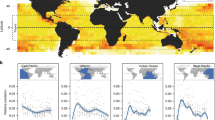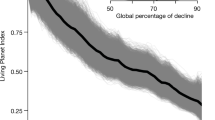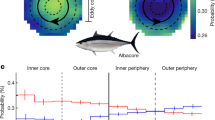Abstract
Large teleost (bony) fish are a dominant group of predators in the oceans and constitute a major source of food and livelihood for humans. These species differ markedly in morphology and feeding habits across oceanic regions; large pelagic species such as tunas and billfish typically occur in the tropics, whereas demersal species of gadoids and flatfish dominate boreal and temperate regions. Despite their importance for fisheries and the structuring of marine ecosystems, the underlying factors determining the global distribution and productivity of these two groups of teleost predators are poorly known. Here, we show how latitudinal differences in predatory fish can essentially be explained by the inflow of energy at the base of the pelagic and benthic food chain. A low productive benthic energy pathway favours large pelagic species, whereas equal productivities support large demersal generalists that outcompete the pelagic specialists. Our findings demonstrate the vulnerability of large teleost predators to ecosystem-wide changes in energy flows and hence provide key insight to predict the responses of these important marine resources under global change.
This is a preview of subscription content, access via your institution
Access options
Access Nature and 54 other Nature Portfolio journals
Get Nature+, our best-value online-access subscription
$29.99 / 30 days
cancel any time
Subscribe to this journal
Receive 12 digital issues and online access to articles
$119.00 per year
only $9.92 per issue
Buy this article
- Purchase on Springer Link
- Instant access to full article PDF
Prices may be subject to local taxes which are calculated during checkout




Similar content being viewed by others
References
Rooney, N., McCann, K., Gellner, G. & Moore, J. C. Structural asymmetry and the stability of diverse food webs. Nature 442, 265–269 (2006).
Estes, J. A., Heithaus, M., McCauley, D. J., Rasher, D. B. & Worm, B. Megafaunal impacts on structure and function of ocean ecosystems. Annu. Rev. Environ. Resour. 41, 83–116 (2016).
Heithaus, M. R., Frid, A., Wirsing, A. J. & Worm, B. Predicting ecological consequences of marine top predator declines. Trends Ecol. Evol. 23, 202–210 (2008).
Baum, J. K. & Worm, B. Cascading top-down effects of changing oceanic predator abundances. J. Anim. Ecol. 78, 699–714 (2009).
The State of World Fisheries and Aquaculture 2016. Contributing to Food Security and Nutrition For All (FAO, Rome, 2016).
Link, J. S., Bogstad, B., Sparholt, H. & Lilly, G. R. Trophic role of Atlantic cod in the ecosystem. Fish Fish. 10, 58–87 (2009).
Sibert, J., Hampton, J., Kleiber, P. & Maunder, M. Biomass, size, and trophic status of top predators in the Pacific Ocean. Science 314, 1773–1776 (2006).
Boyce, D. G., Tittensor, D. P. & Worm, B. Effects of temperature on global patterns of tuna and billfish richness. Mar. Ecol. Prog. Ser. 355, 267–276 (2008).
Worm, B. & Tittensor, D. P. Range contraction in large pelagic predators. Proc. Natl Acad. Sci. USA 108, 11942–11947 (2011).
Pauly, D., Watson, R. & Alder, J. Global trends in world fisheries: impacts on marine ecosystems and food security. Phil. Trans. R. Soc. B 360, 5–12 (2005).
Garrison, L. P. & Link, J. S. Dietary guild structure of the fish community in the northeast United States continental shelf ecosystem. Mar. Ecol. Prog. Ser. 202, 231–240 (2000).
Bulman, C., Althaus, F., He, X., Bax, N. J. & Williams, A. Diets and trophic guilds of demersal fishes of the south-eastern Australian shelf. Mar. Freshw. Res. 52, 537–548 (2001).
Byron, C. J. & Link, J. S. Stability in the feeding ecology of four demersal fish predators in the US Northeast Shelf Large Marine Ecosystem. Mar. Ecol. Prog. Ser. 406, 239–250 (2010).
López-López, L. et al. Is juvenile anchovy a feeding resource for the demersal community in the Bay of Biscay? On the availability of pelagic prey to demersal predators. ICES J. Mar. Sci. 69, 1394–1402 (2012).
Watson, R. A. A database of global marine commercial, small-scale, illegal and unreported fisheries catch 1950–2014. Sci. Data 4, 170039 (2017).
Spalding, M. D. et al. Marine ecoregions of the world: a bioregionalization of coastal and shelf areas. BioScience 57, 573–583 (2007).
Branch, T. A. et al. The trophic fingerprint of marine fisheries. Nature 468, 431–435 (2010).
Ricard, D., Minto, C., Jensen, O. P. & Baum, J. K. Examining the knowledge base and status of commercially exploited marine species with the RAM Legacy Stock Assessment Database. Fish Fish. 13, 380–398 (2012).
Sumaila, U. R., Marsden, A. D., Watson, R. & Pauly, D. A global ex-vessel fish price database: construction and applications. J. Bioeconomics 9, 39–51 (2007).
Suess, E. Particulate organic carbon flux in the oceans—surface productivity and oxygen utilization. Nature 288, 260–263 (1980).
Pomeroy, L. R. & Deibel, D. O. N. Temperature regulation of bacterial activity during the spring bloom in Newfoundland coastal waters. Science 233, 359–361 (1986).
Laws, E. A., Falkowski, P. G., Smith, W. O., Ducklow, H. & McCarthy, J. J. Temperature effects on export production in the open ocean. Glob. Biogeochem. Cycles 14, 1231–1246 (2000).
Lutz, M. J., Caldeira, K., Dunbar, R. B. & Behrenfeld, M. J. Seasonal rhythms of net primary production and particulate organic carbon flux to depth describe the efficiency of biological pump in the global ocean. J. Geophys. Res. 112, C10011 (2007).
Dunne, J. P., Armstrong, R. A., Gnanadesikan, A. & Sarmiento, J. L. Empirical and mechanistic models for the particle export ratio. Glob. Biogeochem. Cycles 19, GB4026 (2005).
Tittensor, D. P. et al. Global patterns and predictors of marine biodiversity across taxa. Nature 466, 1098–1101 (2010).
Mackintosh, N. A. The pattern of distribution of the Antarctic fauna. Proc. R. Soc. Lond. B. 152, 624–631 (1960).
Kaschner, K., Tittensor, D. P., Ready, J., Gerrodette, T. & Worm, B. Current and future patterns of global marine mammal biodiversity. PLoS ONE 6, e19653 (2011).
Davidson, L. N. K., Krawchuk, M. A. & Dulvy, N. K. Why have global shark and ray landings declined: improved management or overfishing? Fish Fish. 17, 438–458 (2016).
Drapeau, L., Pecquerie, L., Fréon, P. & Shannon, L. J. Quantification and representation of potential spatial interactions in the southern Benguela ecosystem. African J. Mar. Sci. 26, 141–159 (2004).
Brodeur, R. D., Buchanan, J. C. & Emmett, R. L. Pelagic and demersal fish predators on juvenile and adult forage fishes in the Northern California Current: spatial and temporal variations. CalCOFI Rep. 55, 96–116 (2014).
McDaniel, J., Piner, K., Lee, H. H. & Hill, K. Evidence that the migration of the northern subpopulation of Pacific sardine (Sardinops sagax) off the west coast of the United States is age-based. PLoS ONE 11, e0166780 (2016).
Varpe, Ø., Fiksen, Ø. & Slotte, A. Meta-ecosystems and biological energy transport from ocean to coast: the ecological importance of herring migration. Oecologia 146, 443–451 (2005).
Killen, S. S. et al. Ecological influences and morphological correlates of resting and maximal metabolic rates across teleost fish species. Am. Nat. 187, 592–606 (2016).
Watanabe, Y. Y., Goldman, K. J., Caselle, J. E., Chapman, D. D. & Papastamatiou, Y. P. Comparative analyses of animal-tracking data reveal ecological significance of endothermy in fishes. Proc. Natl Acad. Sci. USA 112, 6104–6109 (2015).
Stock, C. A. et al. Reconciling fisheries catch and ocean productivity. Proc. Natl Acad. Sci. USA 114, E1441–E1449 (2017).
Brander, K. M. Global fish production and climate change. Proc. Natl Acad. Sci. USA 104, 19709–19714 (2007).
Capotondi, A., Alexander, M. A., Bond, N. A., Curchitser, E. N. & Scott, J. D. Enhanced upper ocean stratification with climate change in the CMIP3 models. J. Geophys. Res.-Oceans 117, C04031 (2012).
Sarmiento, J. L. et al. Response of ocean ecosystems to climate warming. Glob. Biogeochem. Cycles 18, GB3003 (2004).
Richardson, A. J. & Schoeman, D. S. Climate impact on plankton ecosystems in the northeast Atlantic. Science 305, 1609–1612 (2004).
Behrenfeld, M. J. et al. Climate-driven trends in contemporary ocean productivity. Nature 444, 752–755 (2006).
Compagno, L. J. V. in Sharks of the Open Ocean: Biology, Fisheries and Conservation (eds Camhi, M. D., Pikitch, E. K. & Babcock, E. A.) Ch. 3 (Blackwell, Oxford, 2008).
Behrenfeld, M. J. & Falkowski, P. G. Photosynthetic rates derived from satellite-based chlorophyll concentration. Limnol. Oceanogr. 42, 1–20 (1997).
Friedland, K. D. et al. Pathways between primary production and fisheries yields of large marine ecosystems. PLoS ONE 7, e28945 (2012).
Morel, A. & Berthon, J.-F. Surface pigments, algal biomass profiles, and potential production of the euphotic layer: relationships reinvestigated in view of remote-sensing applications. Limnol. Oceanogr. 34, 1545–1562 (1989).
Martin, J. H., Knauer, G. A., Karl, D. M. & Broenkow, W. W. VERTEX: carbon cycling in the northeast Pacific. Deep Sea Res. A 34, 267–285 (1987).
Amante, C. & Eakins, B. W. ETOPO1 1 Arc-Minute Global Relief Model: Procedures, Data Sources and Analysis NOAA Technical Memorandum NESDIS NGDC-24 (NOAA, Boulder, 2009).
Ward, C. L., McCann, K. S. & Rooney, N. HSS revisited: multi-channel processes mediate trophic control across a productivity gradient. Ecol. Lett. 18, 1190–1197 (2015).
Richardson, K., Visser, A. W. & Pedersen, F. B. Subsurface phytoplankton blooms fuel pelagic production in the North Sea. J. Plankton Res. 22, 1663–1671 (2000).
Schulien, J. A., Behrenfeld, M. J., Hair, J. W., Hostetler, C. A. & Twardowski, M. S. Vertically-resolved phytoplankton carbon and net primary production from a high spectral resolution lidar. Opt. Express 25, 13577–13587 (2017).
Jónasdóttir, S. H., Visser, A. W., Richardson, K. & Heath, M. R. Seasonal copepod lipid pump promotes carbon sequestration in the deep North Atlantic. Proc. Natl Acad. Sci. USA 112, 12122–12126 (2015).
Davison, P. C., Checkley, D. M., Koslow, J. A. & Barlow, J. Carbon export mediated by mesopelagic fishes in the northeast Pacific Ocean. Prog. Oceanogr. 116, 14–30 (2013).
Siegel, D. A. et al. Global assessment of ocean carbon export by combining satellite observations and food-web models. Glob. Biogeochem. Cycles 28, 181–196 (2014).
Belkin, I. M. Rapid warming of large marine ecosystems. Prog. Oceanogr. 81, 207–213 (2009).
Jennings, S. & Collingridge, K. Predicting consumer biomass, size-structure, production, catch potential, responses to fishing and associated uncertainties in the world’s marine ecosystems. PLoS ONE 10, e0133794 (2015).
Smithson, M. & Verkuilen, J. A better lemon squeezer? Maximum-likelihood regression with beta-distributed dependent variables. Psychol. Methods 11, 54–71 (2006).
South, A. rworldmap: a new R package for mapping global data. R J. 3, 35–43 (2011).
Acknowledgements
We thank N. S. Jacobsen for help with the RAM Legacy Stock Assessment Database, C. A. Stock for advice on the energy fluxes, U. R. Sumaila for making the global fish prices available and H. van Someren Gréve for Fig. 1,3 and 4 fish illustrations. P.D.v.D., M.L. and K.H.A. conducted the work within the Centre for Ocean Life—a Villum Kann Rasmussen Center of Excellence supported by the Villum Foundation. P.D.v.D. received funding from the People Programme (Marie Curie Actions) of the European Union’s Seventh Framework Programme (FP7/2007-2013) under Research Executive Agency grant agreement number 609405 (COFUNDPostdocDTU). M.L. is supported by a VILLUM Young Investigator grant (13159). R.A.W. acknowledges support from the Australian Research Council (Discovery Project DP140101377).
Author information
Authors and Affiliations
Contributions
P.D.v.D., M.L., B.R.M. and K.H.A. conceived the study. R.A.W. contributed fisheries landings data. P.D.v.D. performed the research with support from M.L. and K.H.A. P.D.v.D., M.L. and K.H.A. wrote the paper. All authors contributed to interpretation of the results and commented on the paper.
Corresponding author
Ethics declarations
Competing interests
The authors declare no competing financial interests.
Additional information
Publisher’s note: Springer Nature remains neutral with regard to jurisdictional claims in published maps and institutional affiliations.
Electronic supplementary material
Supplementary Information
Supplementary Figures 1–7, Supplementary Tables 1–6
Supplementary Data
Information per ecoregion on the fraction pelagic fish in landings, environmental variables and the food-web model outcome
Rights and permissions
About this article
Cite this article
van Denderen, P.D., Lindegren, M., MacKenzie, B.R. et al. Global patterns in marine predatory fish. Nat Ecol Evol 2, 65–70 (2018). https://doi.org/10.1038/s41559-017-0388-z
Received:
Accepted:
Published:
Issue Date:
DOI: https://doi.org/10.1038/s41559-017-0388-z
This article is cited by
-
Similar trait structure and vulnerability in pelagic fish faunas on two remote island systems
Marine Biology (2022)
-
Pelagic fish predation is stronger at temperate latitudes than near the equator
Nature Communications (2020)
-
Biological and environmental drivers of trophic ecology in marine fishes - a global perspective
Scientific Reports (2019)
-
Marine fish traits follow fast-slow continuum across oceans
Scientific Reports (2019)
-
Independent losses of a xenobiotic receptor across teleost evolution
Scientific Reports (2018)



